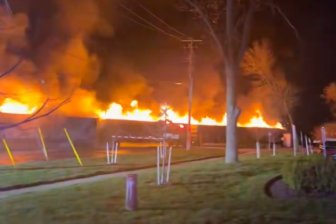The deadly heat dome that smothered the Pacific Northwest in record-high temperatures for weeks in 2021 was made much worse by climate change, a new study suggests, and intensified that year’s North American wildfire season — a possible model of summers to come.
The study, published Monday in Communications Earth and Environment, concluded the heat dome in June and July 2021 was 34 per cent larger and lasted 59 per cent longer than a similar event would have without global warming. The sweltering temperatures across British Columbia, Washington and Oregon were subsequently linked to fires that accounted for up to one-third of the total area burned across the continent that year.
Researchers looking back on the past 40 years of data also found the 2021 heat dome was 36 per cent stronger and nearly 40 per cent larger than the next largest event of that kind, which took place in the summer of 2003.
“When we look at the trends … we find that these events are becoming more intense,” said Piyush Jain, the study’s lead author and a research scientist with the Canadian Forest Service and Natural Resources Canada.
The 2021 heat dome lasted 27 days, from June 18 to July 14, and was directly responsible for hundreds of deaths across western Canada and the United States, including more than 600 deaths in B.C. alone.
The town of Lytton, B.C., recorded the highest temperature ever seen in Canada in the middle of the phenomenon — 49.6 degrees Celsius — and was completely destroyed by a wildfire that began a day later.

Jain, who lives in Edmonton, said he also experienced unusually high temperatures that summer which told him he was experiencing an “extraordinary” climate event.
“We had a day where it was 38 degrees Celsius, which is the only time it’s been that hot the whole time I’ve lived here for 15 years now,” he said.
In the U.S., both Seattle and Portland, Ore., repeatedly shattered maximum temperature records on consecutive days in late June 2021, according to the U.S. National Oceanic and Atmospheric Administration (NOAA). Other states that were technically outside the heat dome, including California and as far east as Montana, also broke or tied their own heat records for that time period.
That summer also saw an extraordinarily severe wildfire season, which the new study says was “unequivocally intensified by the presence of the heat dome.” About 3.2 million hectares burned across North America in July 2021 alone, according to researchers, the highest area recorded in a single month over the previous 20 years.
Smoke from the fires in Canada and the U.S. spread as far east as New Brunswick and New York City.
The researchers found 21 per cent of the land burned in North America that year was due to fires that ignited during and within the heat dome. That figure rose to 34 per cent when including fires that sparked within 10 days of the event.

The “widespread and synchronous” wildfires across the Pacific Northwest and beyond also strained firefighting resources, the study says, and kept national emergency preparedness levels at the highest threshold in both Canada and the U.S. for record-breaking periods of time (50 and 69 days, respectively).
Jain said the issue of strained resources was also seen during the 2023 wildfire season, which once again shattered records for area burned — this time for an entire season in North American history. As more regions that typically share firefighting crews face their own fire risks simultaneously, the harder it will be to battle them effectively, he said.
“That is a concern going into the future that under a warming climate, we may see firefighting resources even more constrained,” he said.
The study builds off an earlier method developed by Jain and other researchers to track extreme weather events and their severity over time. That research determined a trend of rising high pressure systems due to the thermodynamic warming of the atmosphere due to anthropogenic, or human-caused, climate change.
Without that trend, the new study concluded, the 2021 heat dome would have been about two-thirds the size and 59 per cent shorter — nearly 16 fewer days of extreme heat.

The study adds to a growing field of climate change-confirming research that other scientists say is important to further build on.
“Even though we know in the future climate model that we’re going to have a warmer climate, we’re going to have more intense heatwaves, we still have a lot of uncertainty in how the processes contribute to those events,” said Lualawi Admasu, a PhD student studying atmospheric science at the University of British Columbia.
“So these studies compile together to give us a more holistic view of, what are the processes that are important, in this specific case of fire weather. … That’s really important for the climate change (research) community).”
Jain said it was also important for him to “connect the dots” through science to underscore what more and more people are concluding: that the warming climate is directly contributing to both more extreme weather events and fire risk.
“If we can make these connections between these extreme events and climate change, it may inform policy,” he said.
“I think it’s important to carry on putting out this message so that we can have a greater understanding in our societies that this is actually what’s happening.”
More on Science and Tech
© 2024 Global News, a division of Corus Entertainment Inc.


